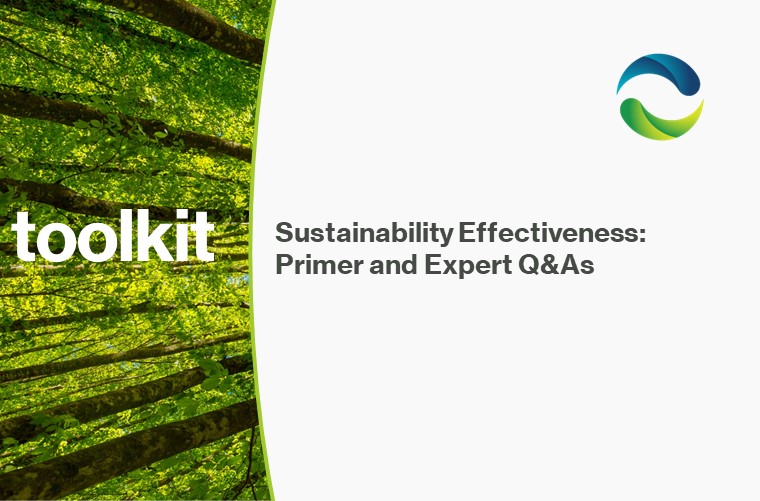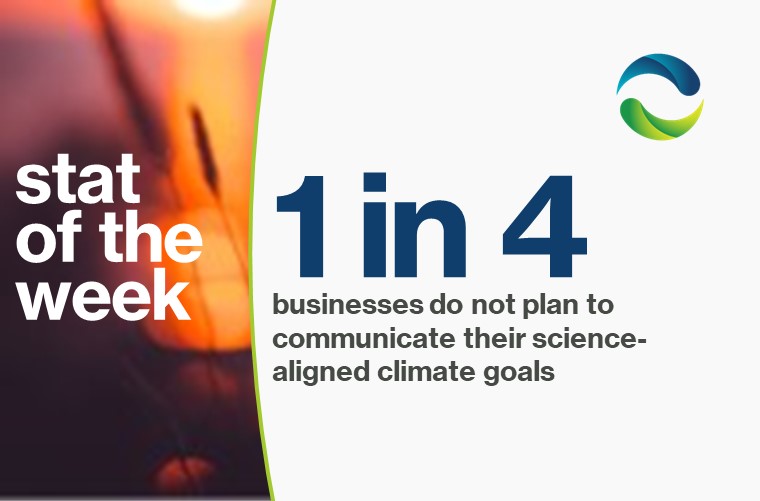ESG is under attack. What should executives do?
The SEC has backed off mandating Scope 3 disclosures. Large financial firms such as State Street and J.P. Morgan Asset Management have exited the Climate Action 100+ voluntary investment initiative. Firms are shuttering DEI programs. How can corporate executives navigate the “ESG backlash”?
Environmental, social and governance efforts face significant backlash in the political and media arenas – particularly when they are branded as “ESG” or “DEI.” At risk are some of the initiatives and policies that cement the components of ESG into organizations’ long-term procedures and practices. But corporate executives need to take the long view even as they take the shifting winds seriously; the significance of sustainability as a competitive, operational, compliance and branding mechanism will continue to grow over time. Just as importantly, as climate-related events rise in frequency and severity – dramatically in many cases – executives don’t want to be caught flat-footed.
Here’s how corporate executives are navigating a more complicated external and internal environment.
The State of Play
Most major firms have ESG policies and/or statements of purpose in place. More than 95 percent of large companies have reported ESG information. Almost 2/3 of the world’s biggest companies by revenue have adopted a net zero target. States such as Illinois have passed legislation requiring investment managers to integrate sustainability factors into their decision-making. The European Union’s Corporate Sustainability Reporting Directive (CSRD) imposes detailed reporting requirements, starting this year.
Despite ESG’s momentum, the backlash is real. The challenges primarily affect the “S” component of ESG: an organization’s “Social” behaviors affecting individuals and groups. Well-known examples of those challenges are the internet-organized boycotts against M&M candies, Bud Light beer and Target stores. But the “E” is under attack as well, particularly in the financial arena. Eleven US states have passed legislation that limits or prohibits their investment funds and advisers from taking ESG factors into consideration. “Greenhushing” – being less public about sustainability efforts – has become more widespread.
What Should Corporate Executives Do Now?
As a recent article in the Harvard Business Review noted, the “ESG backlash” comes from different sources and motivations, and executives should understand the complexity of the landscape and respond appropriately.
More importantly, though, executives need to first decide what their priorities on ESG issues are; the extent to which anti-ESG legislation, rules and customer action will affect their company; and then decide a path forward. Critically, executives will need to decide how public they will be in their environmental and social efforts, and whether they want to fold progress on these issues into more general corporate metrics rather than call them out separately.
For now, the ferocity of the ESG backlash exceeds its real-world effect. Executives at large enterprises with diverse stakeholders, operating in multiple jurisdictions, should remain prudent about reacting to the backlash. Consider the following:
Most corporate initiatives are unlikely to attract significant scrutiny. A company that decides to reduce GHG emissions or adopt certain Diversity, Equity, and Inclusion (DEI) initiatives generally won’t be targeted unless it is high-profile (such as Disney) or particularly vulnerable to political pressure or action. While executives need to be more mindful of messaging and the views of their stakeholders, there’s no immediate reason for many companies (and particularly those outside the United States) to course-correct. Indeed, too radical or public a reversal can alienate key constituencies who favor continued progress. Many stakeholders (consumers, buyers, investors, regulators) will continue to demand action on environmental and social issues.
ESG blowback will depend on many factors, such as your industry, your company’s geographical footprint, and whether it is B2B or B2C. Texas, for example, has banned several investment firms that incorporate emissions reductions in lending/investing decisions, most recently Barclays. But other jurisdictions require integration of ESG into investment decisions. In some cases, firms will have to choose sides. In the US, financial firms should consider stepping back from public positioning and do business more quietly, as many now are; this appears to be less imperative in Europe.
ESG policies appeal to many customers, employees, and shareholders. In spite of the noisy and real opposition to some corporate environmental and DEI initiatives, their basic business case remains and will likely deepen. Products that are marketed as sustainable continue to grow their market share. Nearly $30 trillion in assets is allocated to sustainable investing. Many employees choose their employers in part based on their diversity. However, for national consumer brands that advertise extensively, marketing and sales executives will need to tread more carefully given the experiences of Bud Light and Target.
Policy and Regulation will continue to drive ESG. The SEC recently published its climate disclosure rules (although as noted below they will be subject to protracted litigation). The EU’s Corporate Responsibility Reporting Directive (CSRD) requires tens of thousands of large businesses operating in Europe to report in detail on their sustainability programs and outcomes. California recently passed a pair of laws requiring disclosure of emissions (including those of a reporting company’s suppliers and customers) and financial risks from climate change. Proposed laws, regulations, and executive orders are in force or under consideration in numerous countries, states, and territories around the world. They range from mandated corporate functions and reporting to penalties for noncompliance, even in the absence of mandated disclosure or reporting. The Climate Board tracks these rules and regulations for its members, and continues to see a proliferation of new government initiatives.
Risk Awareness and Management
Notwithstanding our general advice to stay the course, there are some emerging and serious risks that executives need to consider.
The US Election and a Hostile Government. Most obvious is this year’s US Presidential and Congressional elections. Should Republicans win the Presidency, or take control of both houses of Congress, both legislative and executive initiatives may be curtailed or reversed. Executive orders to promote DEI and other social initiatives likely would be ended quickly, but environmental legislation and regulation (e.g. at the SEC) also would be affected.
For companies that are counting on grants and tax incentives in the Infrastructure Investment and Jobs Act (IIJA) and the Inflation Reduction Act (IRA), there is the risk that some of decarbonization incentives will be cut back or eliminated. The IIJA provides funding for public transportation, airports/ports, resilience, clean transmission and grid enhancement, and EV chargers; the IRA provides tax and other incentives for the production of clean energy. It is unlikely that most of these incentives will be eliminated altogether, since so many companies (many in Republican-led states) have staked their business models on them. Last year, Texas legislators rejected attempts to cripple renewables after opposition from clean-energy businesses. Nevertheless, some action to reduce government funding in this space is likely.
Furthermore, the Supreme Court is increasingly hostile to environmental regulation (as are many lower courts, such as the 5th Circuit which imposed a temporary stay on the SEC rules). It recently used a “major questions” doctrine to strike down an EPA regulation that would have set an emissions cap for power plants, holding that Congress had to give clear authorization to adopt a rule that would force utilities to transition from coal. A set of Supreme Court cases this year will likely weaken or overturn that a legal doctrine that has given administrative agencies significant latitude to interpret their own statutes, giving the courts greater power to strike down implementing rules for the IRA, The Infrastructure Act and regulations under existing statutes. In California, business groups have challenged climate disclosure rules and may well get a sympathetic hearing from the current Supreme Court.
EU Elections and Corporate Pushback. The EU has been leading the way on much climate regulation through its CSRD and an import “Border Adjustment Tax” for carbon. The upcoming European Parliament elections, however, may well result in increased prominence of “populist” parties that are hostile to climate regulation, mirroring the US trend. Recently, the EU delayed implementation of key aspects of its CSRD after corporate pushback.
Geopolitical risks. Protracted war and instability in the Middle East, coupled with continued economic pressure on Europe stemming from the Russian invasion of Ukraine, may lead to higher oil prices that strengthen the policy influence of fossil-fuel interests and divert attention from climate risks. On the flip side, continued price and supply volatility for fossil fuels may speed adoption of renewables.
TCB’s Long View on Corporate Sustainability Issues
Over the longer term, TCB believes that the corporate initiatives captured under the ESG rubric will resume their momentum in global policy development, even as “ESG” itself recedes. While we expect to see continued resistance to cultural aspects of the “Social” component, the “Environmental” component will be driven by two imperatives: climate change mitigation and avoidance, and technology developments that drive down costs for renewable energy and make sustainability policies more economic.
- As global warming disrupts a physical environment centered on a once-stable climate that is now changing rapidly, the political, consumer and industry pressure to address both GHG emissions and its effects will continue to build. Customers, employees, buyers and investors thus will continue to drive sustainability.
- Corporations increasingly will feel the effects of climate change in the form of rising insurance rates; business disruptions due to fires, floods, and droughts; and more expensive input prices due to climate-related effects. Insurance rates for property, for example, are increasing far faster than other types of insurance – up 6% in the last quarter alone. All of this likely will raise alarm in the business community and lead to calls for action.
- Continued technical innovation in clean energy will continue to drive down costs and speed deployment, which will make achievement of sustainability goals not only necessary but consistent with business efficiency and profit imperatives.
TCB’s Advice to Executives:
Your C-suite and board are likely to have three key questions this year regarding the “ESG backlash.” (1) What effect will the elections have on ESG policy and legislation? (2) What emerging policies and regulations require investment for compliance and competitive advantage? and (3) How do I navigate the crosscurrents of warring constituencies and demanding stakeholders on ESG? The answers will vary by organization, of course.
- On your existing ESG positioning: There is no reason to panic or overreact to current political turbulence, but make sure your company’s existing ESG initiatives are reviewed and updated as necessary.
- Decide on your business and “ESG” priorities based on an unemotional, fact-based discussion. Make sure that environmental and social goals align with your business strategy. Validate these goals and priorities if you think environmental and social policies can drive positive results, whether in the workforce, operations, or sales. And validate which parts of ESG matter most; not all companies will weigh ESG components or sub-components equally, and companies should periodically revisit their environmental and social priorities in any event.
- Companies should ensure alignment between the strategic business plan, investor relations, and corporate responsibility initiatives. Executives should ensure that they are aware of flashpoints related to “ESG” and have a corporate crisis action plan.
- Develop a messaging and action plan for the CEO and the Board that discusses the crosscurrents of the ESG backlash, acknowledges the continued forces driving climate and social progress forward, and adjusts messaging and action as necessary.
TCB stands ready to assist executives in choosing the right path forward.



